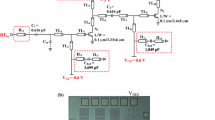Abstract
This paper demonstrates novel technique to devise a three-stage millimeter-wave low noise amplifier (LNA) operated at 76–77 GHz frequency band used in long range automotive Radar application. LNA having high power gain along with low noise figure is necessary for long range automotive Radar application. High power gain is one of the biggest challenges in the LNA design of the long range automotive application (nearly 40 dB power loss of received echo signal). Here, we propose a novel method to design an LNA using three configurations, i.e., cascaded, cascoded and differential. Design methodology used for this proposed LNA are also discussed in this paper. Power, small-signal, noise and stability analysis of post-layout and RC-extracted novel LNA are carried for the same. The proposed LNA is implemented in 45 nm complementary metal oxide semiconductor process, and its results show 2.4 dB noise factor 38–40 dB maximum power gain. It also provides outstanding stability and minimum size which is best suitable for Automotive integrated Radar sensor.






Similar content being viewed by others
References
F. Akbar, M. Atarodi, S. Saeedi, Design method for a reconfigurable CMOS LNA with input tuning and active balun. AEU Int. J. Electron. Commun. 69(1), 424–431 (2015). https://doi.org/10.1016/j.aeue.2014.10.019
S. Arshad, R. Ramzan, K. Muhammad, Q. ul Wahab, A sub-10 mW, noise cancelling, wideband LNA for UWB applications. AEU Int. J. Electron. Commun. 69(1), 109–118 (2015). https://doi.org/10.1016/j.aeue.2014.08.002
R. Carmon, R. Ben-Yishay, O. Katz, B. Sheinman, D. Elad, A 71-76GHz low noise amplifier with integrated image reject filter and single balanced down converter mixer, in 2011 IEEE International Conference on Microwaves, Communications, Antennas and Electronic Systems (COMCAS 2011) (IEEE, 2011). https://doi.org/10.1109/comcas.2011.6105873
T.C. Carrillo, J.G. Macias-Montero, A.O. Martí, J.S. Córdoba, J.M. Lopez-Villegas, Cmos single-ended-to-differential low-noise amplifier. Integr. VLSI J. 42(3), 304–311 (2009)
M. Fahimnia, M. Nezhad-Ahamadi, B. Biglarbeigian, S. Safavi-Naieni, M. Mohammad-Taheri, Y. Wang, A 77 GHz low noise amplifier using low-cost 0.13 \(\mu \)m CMOS technology, in Microsystems and Nanoelectronics Research Conference, 2009. MNRC 2009. 2nd (IEEE, 2009), pp. 73–75
L. Gao, Q. Ma, G.M. Rebeiz, A 4.7 mW W-band LNA with 4.2 db NF and 12 db gain using drain to gate feedback in 45nm cmos rfsoi technology, in 2018 IEEE Radio Frequency Integrated Circuits Symposium (RFIC) (IEEE, 2018), pp. 280–283
N. Gautam, M. Kumar, A. Chaturvedi, A 3.1–10.6 GHz CMOS two stage cascade topology low-noise amplifier for UWB system, in 2014 Fourth International Conference on Communication Systems and Network Technologies (IEEE, 2014). https://doi.org/10.1109/csnt.2014.218
G. Gonzalez, Microwave Transistor Amplifiers: Analysis and Design, vol. 2 (Prentice Hall, Upper Saddle River, 1997)
R. Guan, J. Jin, W. Pan, D. Chen, J. Zhou, Wideband dual-mode complementary metal-oxide-semiconductor receiver. IET Circuits Dev. Syst. 10(6), 87–93 (2016)
M. Hayati, S. Cheraghaliei, S. Zarghami, Design of UWB low noise amplifier using noise-canceling and current-reused techniques. Integr. VLSI J. 60, 232–239 (2018)
D. Huang, S. Diao, W. Qian, F. Lin, A resistive-feedback LNA in 65 nm CMOS with a gate inductor for bandwidth extension. Microelectron. J. 46(1), 103–110 (2015). https://doi.org/10.1016/j.mejo.2014.10.012
R. Jafarnejad, A. Jannesari, J. Sobhi, A linear ultra wide band low noise amplifier using pre-distortion technique. AEU Int. J. Electron. Commun. 79(Supplement C), 172–183 (2017). https://doi.org/10.1016/j.aeue.2017.05.046
C.H. Lee, W.Y. Choi, J.H. Kim, Y.W. Kwon, A 77 GHz 3-stage low noise amplifier with cascode structure utilizing positive feedback network using 0.13 \(\mu \)m CMOS process. JSTS J. Semicond. Technol. Sci. 8(4), 289–294 (2008). https://doi.org/10.5573/jsts.2008.8.4.289
Y.S. Lin, C.Y. Lee, 9.99 mW 4.8 dB NF 57–81 GHz CMOS low-noise amplifier for 60 GHz WPAN system and 77 GHz automobile radar system. Microw. Opt. Technol. Lett. 57(3), 594–600 (2015). https://doi.org/10.1002/mop.28898
Y.S. Li, G.L. Lee, C.C. Wang, C.C. Chen, A 21.1 mW 6.2 dB NF 77-81 GHz CMOS low-noise amplifier with 13.5\(\pm \)0.5 dB S21 and excellent input and output matching for automotive radars(2014), pp. 73–75. https://doi.org/10.1109/RWS.2014.6830087
Y.S. Lin, C.C. Chen, C.Y. Lee, 7.2 mW CMOSlow-noise amplifier with 17.3 dB gain and 7.7 dB NF for 76–77 GHz long-range and 77–81 GHz short-range automotive radars. Analog Integr. Circuits Signal Process. 87(1), 1–9 (2016). https://doi.org/10.1007/s10470-016-0711-7
M.A.G. Lorenzo, M.T.G.. de Leon, Comparison of LNA topologies for WiMAX applications in a standard 90-nm CMOS process, in 2010 12th International Conference on Computer Modelling and Simulation (UKSim), (IEEE, 2010), pp. 642–647
D.M.D.M. Pozar, Microwave and RF Wireless Systems (Wiley, New York, 2001)
A.K. Ray, R.C. Shit, Design of ultra-low noise, wideband low-noise amplifier for highly survival radar receiver. IET Circuits Dev. Syst. 10(7), 473–480 (2016)
B. Razavi, R. Behzad, RF Microelectronics, vol. 1 (Prentice Hall, Upper Saddle River, 1998)
A. Saberkari, S. Kazemi, V. Shirmohammadli, M. Yagoub, GM-boosted flat gain UWB low noise amplifier with active inductor-based input matching network. Integr. VLSI J. 52, 323–333 (2016)
X. Sun, B. Chi, C. Zhang, Z. Wang, Z. Wang, Ultra-high-frequency radio frequency identification reader receiver with 10dBm input P1dB and -74dBm sensitivity in 0.18\(\mu \)m CMOS. IET Circuits Dev. Syst. 5(10), 392–402 (2011)
R. Yadav, P.K. Dahiya, R. Mishra, A high performance 76.5 GHz FMCW RADAR for advanced driving assistance system, in 2016 3rd International Conference on Signal Processing and Integrated Networks (SPIN) (IEEE, 2016), pp. 383–388
Y. Yu, K. Kang, Analysis and design of transformer-based CMOS ultra-wideband millimeter-wave circuits for wireless applications: a review. Front. Inf. Technol. Electron. Eng. 21(1), 97–115 (2020)
J.H.C. Yun-Chih Lu, T.-N. Luo, Y.J.E. Chen, A 77-GHz LNA for automotive radar application, in IEEE International Wireless Symposium (IWS) (IEEE, 2013). https://doi.org/10.1109/ieee-iws.2013.6616727
Author information
Authors and Affiliations
Corresponding author
Additional information
Publisher's Note
Springer Nature remains neutral with regard to jurisdictional claims in published maps and institutional affiliations.
Rights and permissions
About this article
Cite this article
Yadav, R., Dahiya, P.K., Mishra, R. et al. A 38–40 dB Power Gain and 2.4 dB NF Three-Stage Cascaded/Cascoded LNA for Long Range Automotive Radar Application. J. Inst. Eng. India Ser. B 102, 1–9 (2021). https://doi.org/10.1007/s40031-020-00511-3
Received:
Accepted:
Published:
Issue Date:
DOI: https://doi.org/10.1007/s40031-020-00511-3




